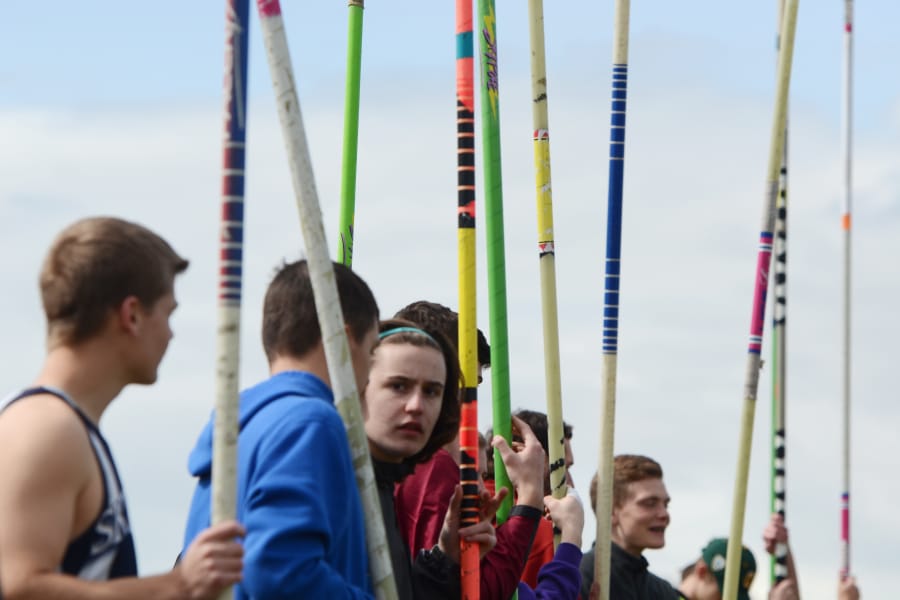Throughout Hockinson’s dual meet at Columbia River on Wednesday, the pole vault pit was only occupied by athletes and coaches wearing Chieftain purple.
And not because Hockinson was a no-show.
The Hawks have fielded many competitive teams over the years, but have never offered pole vault.
It makes Hockinson the only high school in Clark County that has never offered pole vault, though, depending on the year, some schools opt not to due to various reasons such as funding or availability of coaches with a deep knowledge of the field event.
At the end of the meet, the Columbia River boys and girls vaulters swept first through third, each earning the maximum nine points. Those nine points each dual meet is a handicap Hockinson has dealt with since the school opened in 2003.
The sport is expensive to offer, from equipment to coaching, which has caused some schools in Clark County to cease to do so during some seasons.
Hockinson track coach Randy Pearrow hopes one day the team will have pole vaulters. According to Hockinson athletic director Josh Johnson, not including a pit in the original funding of the program before the school’s 2003 opening makes budgeting for one now harder.
Hockinson’s predicament underscores the high costs the startup and upkeep of pole vault demands.
Schools take measures to reduce spending when it comes to pole vault, such as purchasing a hand-me-down pit from a regional small college. Most Clark County schools share poles with each other on a yearly basis, depending on the height and weight of each team’s athletes.
“We have thousands of dollars up in the rafters,” Heritage coach Ryan Hovde said.
A new pit can cost anywhere from $15,000 to $26,000 and a full-range of poles, which differ among height and weight, can cost up to $10,000. That’s a steep price for a sport that, depending on the school, has a relatively low number of participants.
But Johnson says the estimated cost of a pit makes funding for it difficult.
If it were a project that costs between $2,000 and $3,000, the school could fundraise. If it were a capital project, like a new turf field, that costs hundreds of thousands of dollars, then they could take it to voters.
Instead, the only way Johnson sees a pole vault coming to Hockinson is if it were added to a larger project.
“If we were able to pass a bond or levy that was able to redo our main field in turf, it might be something we could tack on,” Johnson said.
But in Feb. 2017, Hockinson residents down voted a capital project levy to replace the existing grass field with turf by a 59.4 percent majority.
As it relates to the pole vault pit, Johnson said the athletic department is in no rush to add the pole vault, adding, “there’s a lot better ways I can spend that money.”
During the 2016-17 season, Hockinson shared its field with the Seton Catholic track and field team while its new facilities were under construction. Seton brought its pole vault pit, so Hockinson allowed its student-athletes to practice the pole vault and even got a coach certified as a vault coach, but ultimately decided against letting them compete (each school needs two certified coaches, per Washington Interscholastic Athletic Association rules).
“That’s just kind of the direction we went,” Pearrow said, “rather than start it and take it away, let’s just not mess with it until if — and when — we can actually get (pole vault) going for good.”
Heritage has not had pole vault in two years due to a shortage of available coaches and Hudson’s Bay used to not offer due to not having a pit, like Hockinson.
Pole vault isn’t offered by track programs at local middle schools, meaning most vaulters in Clark County don’t try it until high school.
Hockinson has never lost kids to transfer because of not offering pole vault, so far as athletic director Josh Johnson and Pearrow are aware. Hovde didn’t definitely know but figured his program has lost prospective pole vaulters to other schools.
Pearrow said not having pole vaulters is a manageable hurdle at invites with multiple teams, where one team is not likely to sweep all nine points. It’s dual meets where the Hawks feel the hurt when it comes to team points.
“I don’t feel like it’s really put us at a major disadvantage, so I’m OK with that,” Pearrow said. “But it’s just the way it is, so you’ve got to deal with the cards you’ve been dealt.”
As for Hockinson, it remains to be seen whether the school will ever offer the event. In the meantime, teams it faces in a dual will try to drum up competition in what essentially serves as a practice. Last Wednesday, River didn’t have any personal bests. Sophomore Spencer Little felt his marks would have been a little bit better if he was competing against an opponent, instead of teammates.
“It would have made a little difference competitively,” he said, adding that he still tried to push himself.
“There was somebody there with a different uniform,” River coach Art Sanderson said. “Especially coming up for our guys who are freshmen and sophomores, coming up each week, just having another color jersey to compete against changes your whole attitude. ‘I’m not going to let him beat me!'”




